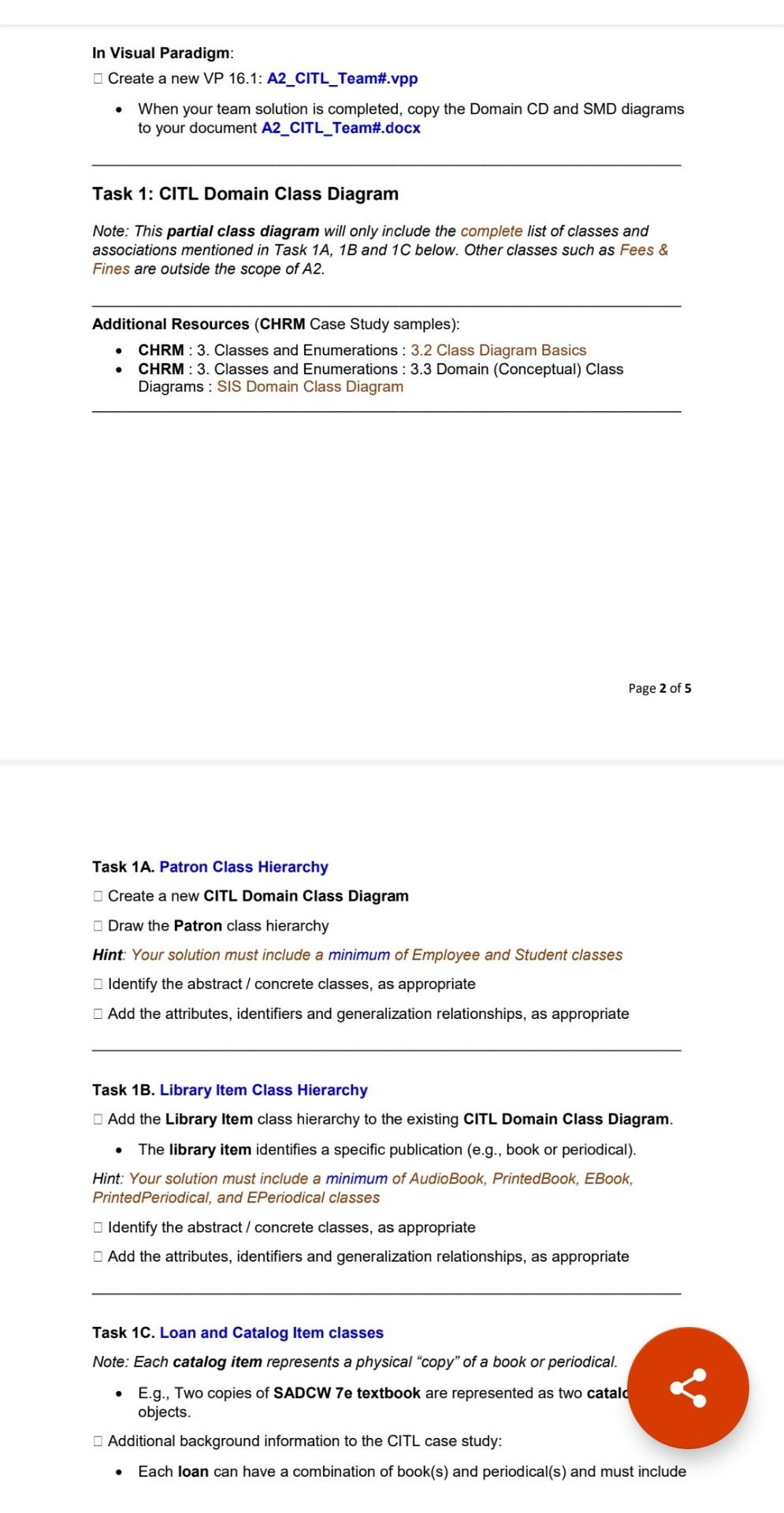Answered step by step
Verified Expert Solution
Question
1 Approved Answer
domain diagrams in visual paradigms In Visual Paradigm: Create a new VP 16.1: A2_CITL_Team#.vpp When your team solution is completed, copy the Domain CD and
domain diagrams in visual paradigms


In Visual Paradigm: Create a new VP 16.1: A2_CITL_Team#.vpp When your team solution is completed, copy the Domain CD and SMD diagrams to your document A2_CITL_Team#.docx . Task 1: CITL Domain Class Diagram Note: This partial class diagram will only include the complete list of classes and associations mentioned in Task 1A, 1B and 1C below. Other classes such as Fees & Fines are outside the scope of A2. Additional Resources (CHRM Case Study samples): CHRM: 3. Classes and Enumerations : 3.2 Class Diagram Basics CHRM : 3. Classes and Enumerations : 3.3 Domain (Conceptual) Class Diagrams: SIS Domain Class Diagram Page 2 of 5 Task 1A. Patron Class Hierarchy Create a new CITL Domain Class Diagram Draw the Patron class hierarchy Hint: Your solution must include a minimum of Employee and Student classes Identify the abstract / concrete classes, as appropriate Add the attributes, identifiers and generalization relationships, as appropriate Task 1B. Library Item Class Hierarchy Add the Library Item class hierarchy to the existing CITL Domain Class Diagram. The library item identifies a specific publication (e.g., book or periodical). Hint: Your solution must include a minimum of Audio Book, PrintedBook, EBook, PrintedPeriodical, and EPeriodical classes Identify the abstract / concrete classes, as appropriate Add the attributes, identifiers and generalization relationships, as appropriate Task 1C. Loan and Catalog Item classes Note: Each catalog item represents a physical "copy" of a book or periodical. E.g., Two copies of SADCW 7e textbook are represented as two catalo objects. Additional background information to the CITL case study: Each loan can have a combination of book(s) and periodical(s) and must include . . The library item identifies a specific publication (e.g., book or periodical). Hint: Your solution must include a minimum of Audio Book, PrintedBook, EBook, PrintedPeriodical, and EPeriodical classes Identify the abstract / concrete classes, as appropriate Add the attributes, identifiers and generalization relationships, as appropriate Task 1C. Loan and Catalog Item classes Note: Each catalog item represents a physical copy" of a book or periodical. . E.g., Two copies of SADCW 7e textbook are represented as two catalog item objects. Additional background information to the CITL case study: Each loan can have a combination of book(s) and periodical(s) and must include the due date(s). Each loan can have one and only one loan type: (a) borrowing, (b) return or (c) renewal transaction. Note: Each loan transaction must have a date/time stamp. CITL has a regular loan period of 14 days (2 weeks). Some high-demand (special) catalog items have a loan period of 7 days (1 week). . Page 3 of 5 Hint: At a minimum, your solution must support this scenario: Day 1: Patron borrows a book (due in 2 weeks) and a special periodical (due in 1 week). Result: Using the library RFID scanner, the system creates a loan with 2 loan items and the catalog item(s) status is set to "On Loan". Day 8: Patron renews the periodical borrowed 7 days ago. Result: Using the Online Web Renewal page, the system creates a loan with a new due date. . Day 15: Patron returns both the book and periodical (both borrowed 14 days ago) to the "RFID-enabled book drop". Result: Using the library RFID scanner, the system creates a loan with 2 loan items and the catalog item(s) status is set to "Available". Tip: Study the sample Sale transaction from Slide 43 of SADCW Chapter 4. Ensure that you understand the Sale - Saleltem - Inventoryltem - Productitem classes and apply them to your solution. Add the classes that represents catalog item and loan transactions to the existing CITL Domain Class Diagram. Add the class attributes, identifiers, associations, relationships and multiplicities, as appropriate. Copy the completed CITL Domain Class Diagram to your solution document A2_CITL_Team#.docx. In Visual Paradigm: Create a new VP 16.1: A2_CITL_Team#.vpp When your team solution is completed, copy the Domain CD and SMD diagrams to your document A2_CITL_Team#.docx . Task 1: CITL Domain Class Diagram Note: This partial class diagram will only include the complete list of classes and associations mentioned in Task 1A, 1B and 1C below. Other classes such as Fees & Fines are outside the scope of A2. Additional Resources (CHRM Case Study samples): CHRM: 3. Classes and Enumerations : 3.2 Class Diagram Basics CHRM : 3. Classes and Enumerations : 3.3 Domain (Conceptual) Class Diagrams: SIS Domain Class Diagram Page 2 of 5 Task 1A. Patron Class Hierarchy Create a new CITL Domain Class Diagram Draw the Patron class hierarchy Hint: Your solution must include a minimum of Employee and Student classes Identify the abstract / concrete classes, as appropriate Add the attributes, identifiers and generalization relationships, as appropriate Task 1B. Library Item Class Hierarchy Add the Library Item class hierarchy to the existing CITL Domain Class Diagram. The library item identifies a specific publication (e.g., book or periodical). Hint: Your solution must include a minimum of Audio Book, PrintedBook, EBook, PrintedPeriodical, and EPeriodical classes Identify the abstract / concrete classes, as appropriate Add the attributes, identifiers and generalization relationships, as appropriate Task 1C. Loan and Catalog Item classes Note: Each catalog item represents a physical "copy" of a book or periodical. E.g., Two copies of SADCW 7e textbook are represented as two catalo objects. Additional background information to the CITL case study: Each loan can have a combination of book(s) and periodical(s) and must include . . The library item identifies a specific publication (e.g., book or periodical). Hint: Your solution must include a minimum of Audio Book, PrintedBook, EBook, PrintedPeriodical, and EPeriodical classes Identify the abstract / concrete classes, as appropriate Add the attributes, identifiers and generalization relationships, as appropriate Task 1C. Loan and Catalog Item classes Note: Each catalog item represents a physical copy" of a book or periodical. . E.g., Two copies of SADCW 7e textbook are represented as two catalog item objects. Additional background information to the CITL case study: Each loan can have a combination of book(s) and periodical(s) and must include the due date(s). Each loan can have one and only one loan type: (a) borrowing, (b) return or (c) renewal transaction. Note: Each loan transaction must have a date/time stamp. CITL has a regular loan period of 14 days (2 weeks). Some high-demand (special) catalog items have a loan period of 7 days (1 week). . Page 3 of 5 Hint: At a minimum, your solution must support this scenario: Day 1: Patron borrows a book (due in 2 weeks) and a special periodical (due in 1 week). Result: Using the library RFID scanner, the system creates a loan with 2 loan items and the catalog item(s) status is set to "On Loan". Day 8: Patron renews the periodical borrowed 7 days ago. Result: Using the Online Web Renewal page, the system creates a loan with a new due date. . Day 15: Patron returns both the book and periodical (both borrowed 14 days ago) to the "RFID-enabled book drop". Result: Using the library RFID scanner, the system creates a loan with 2 loan items and the catalog item(s) status is set to "Available". Tip: Study the sample Sale transaction from Slide 43 of SADCW Chapter 4. Ensure that you understand the Sale - Saleltem - Inventoryltem - Productitem classes and apply them to your solution. Add the classes that represents catalog item and loan transactions to the existing CITL Domain Class Diagram. Add the class attributes, identifiers, associations, relationships and multiplicities, as appropriate. Copy the completed CITL Domain Class Diagram to your solution document A2_CITL_Team#.docx
Step by Step Solution
There are 3 Steps involved in it
Step: 1

Get Instant Access to Expert-Tailored Solutions
See step-by-step solutions with expert insights and AI powered tools for academic success
Step: 2

Step: 3

Ace Your Homework with AI
Get the answers you need in no time with our AI-driven, step-by-step assistance
Get Started


